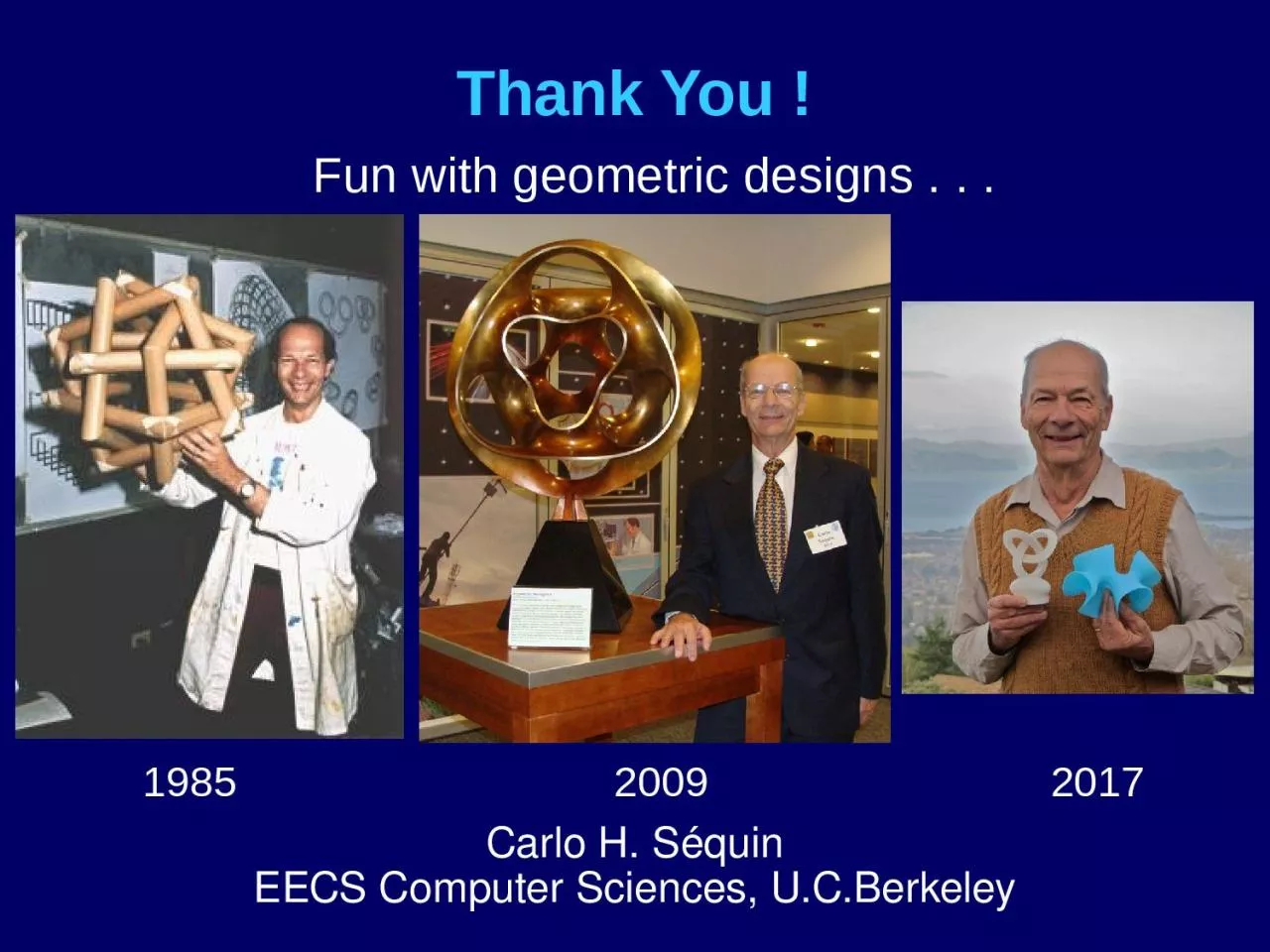

Carlo H Séquin EECS Computer Sciences UCBerkeley Fun with geometric designs 2D Geometry CCD TV Camera RISC I MicroChip Bell Labs 1973 UC Berkeley 1981 ID: 933763
Download Presentation The PPT/PDF document "Thank You ! 1985 ..." is the property of its rightful owner. Permission is granted to download and print the materials on this web site for personal, non-commercial use only, and to display it on your personal computer provided you do not modify the materials and that you retain all copyright notices contained in the materials. By downloading content from our website, you accept the terms of this agreement.
Slide1
Thank You !
1985 2009 2017
Carlo H.
Séquin
EECS Computer Sciences,
U.C.Berkeley
Fun with geometric designs . . .
Slide22D Geometry
CCD TV Camera RISC I MicroChip
Bell Labs (1973) U.C. Berkeley (1981)
Slide3Early Contributions
UNIX + Graphics
“Berkeley UniGrafiX” (1983)
Granny-Knot Lattice Regular 4D 120-Cell
Slide4Solid Modeling Instruction
CS 184 “Introduction to Computer Graphics”
Final Project: “Steerable Cyclist on a Klein Bottle”
Slide5“Star” Graduate Students
Manolis
Katevenis: RISC, 1984
Eric A. Bier: Snap-Dragging, 1988Leon A. Shirman: UniCubiX, 1990
Seth J. Teller: Building Walk-Throughs, 1992
Henry P. Moreton: Min.Variation Surfaces, 1992 Tom Funkhouser: Architectural Models, 1993
Sara
McMains
:
Solid Modeling,
2000
Richard Bukowski:
Indoor Fire Simulations, 2001
Jordan Smith:
Berkeley SLIDE,
2004 Pushkar P. Joshi: Aesthetic Surface Design, 2008
Raph Levien: Euler Spirals, 2009
James Andrews:
Inverse
3D
Modeling, 2013
Three special topics > > >
Slide6Aesthetic Functionals
for Surfaces
Henry P. Moreton: “Minimum Curvature Variation Curves, Networks, and Surfaces for Fair Free-Form Shape
Design” Dec. 18, 1992.
Pushkar
P. Joshi: “Minimizing Curvature Variation for Aesthetic Surface Design” October 2, 2008
Min.Bend.Energy
Min.Curv.Variation
3
rd
order Patch
Slide7Building Walk-Throughs
Seth J. Teller:
“Visibility Computations in Densely Occluded Polyhedral
Environments” Oct. 20, 1992. Tom Funkhouser: “Database and Display Algorithms for Interactive Visualization of Architectural
Models” Sep., 1993.
Soda Hall 5
th
-floor cells
Walkthru
in Atrium
Slide8Design and Fabrication of Solid Models
Sara
McMains: “Data
Representations and Algorithms for Solid Free-form Fabrication” June 29, 2000.
Youngung
Shon, “Development and Evaluation of a Haptic Rendering System for Virtual Design Environments”, 2006
.
Slide9Desirable Developments
Formula-1
Race-Car Non-orientable Surface
Ever more sophisticated CAD tools . . .
But not enough people that can use them.
We need better modeling education!
Slide10A Desirable CAD Environment
Parameterized Procedural Design Initiation +Interactive adjustment of parameter values.
Keep all parameters active and functional
through subdivision smoothing and offsetting!
Slide11A Technical Challenge
bank pb #A bank of parameter definitions:
set rad 5 2 9 1; #Define radius
parameter set sep 4 0 6 1; #Define separation parameterendbank
point p0 ( {pb.rad
} 0 0 ); #Define some points:point p1 ( {-0.5*pb.rad} {0.866*pb.rad} 0 ); #forming equilateral trianglepoint
p2
(
{-0.5*
pb.rad
} {0.866*
pb.rad
}
0 );
#third triangle point
face
triangle
( p0 p1 p2 ); #face spanned by these pointsgroup triapair #A group of transformed faces: instance tn triangle translate( {-pb.sep
} 0 0 ); #shifted negative instance tp
triangle translate(
{
pb.sep
} 0 0
);
#shifted positiveendgroupinstance gview triapair; #Geometry to be displayed
Interactively added face
, defined by hierarchical point-names,
persists
as a
connected rubber sheet
as parameters are changed:
face glue ( gview.
tn
.
p0
gview.
tp
.
p3
gview.
tp
.
p2
);
Slide12CAVEAT
Perhaps some 3D modelers already do most of
this …If this is the case,
-- then this just emphasizes my point made above:
We need better “modeler education”!